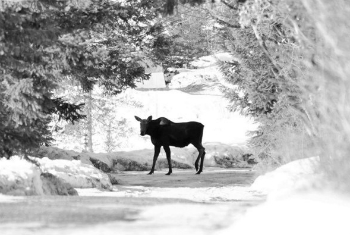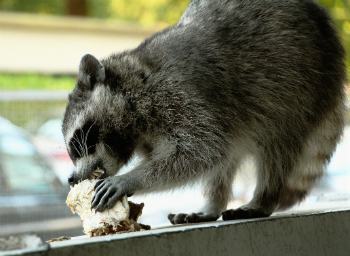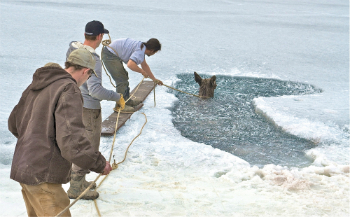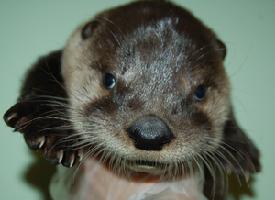|
November 2013
Dear friend,
Wildlife
in BC and across the world face tremendous threats, most of which are
human-caused. Human activities can harm wild animals directly, as seen in the
exotic pet trade, but also indirectly, from things like pollution and
development. Although we are often aware of the intentional harms caused to
wildlife from activities like pest control and feeding wildlife, it is
generally the unintentional harms that have the greatest negative effect on our
wildlife – window impacts, oil spills, cat predation, and vehicle collisions
among others.
With
so many issues to address, populations and individual animals to help, it’s
time for everyone concerned about conservation or animal welfare to work
together on solutions for the future. How can you help? Take action at home or
in your community with the tips in this month’s WildSense – every little bit
can help reduce harms to our wildlife.
With
appreciation,

Sara Dubois
Manager, Wildlife Services
PS. You can multiply your impact! Forward this message to friends, family and colleagues.

700 reasons to reduce
harms to wildlife – Check out images from the 2013 WIF Photo Contest
 Once
again, photographers from across BC rallied to support this year’s
Wildlife-In-Focus Photography Contest – submitting 700 images of our
amazing provincial wildlife! In addition to capturing fantastic photos,
participants raised $3,900 to help injured and orphaned wild animals at Wild
ARC. Check out this year’s incredible winners
and the photos that just made us say “WOW” we live in such a
special place and have the privilege to share it with these wild animals!” Once
again, photographers from across BC rallied to support this year’s
Wildlife-In-Focus Photography Contest – submitting 700 images of our
amazing provincial wildlife! In addition to capturing fantastic photos,
participants raised $3,900 to help injured and orphaned wild animals at Wild
ARC. Check out this year’s incredible winners
and the photos that just made us say “WOW” we live in such a
special place and have the privilege to share it with these wild animals!”
How
can wildlife photography help reduce harms to wildlife? Besides being a
wildlife-friendly activity, it helps the BC SPCA spread the message of wildlife
welfare through powerful images used in our education and advocacy programs. Be
sure to enter the 2014 WIF Photography Contest next July!
Photo Credit: Norman
Ng, BC SPCA 2013 Wildlife-In-Focus Photography Contest – Wild Settings Winner

Federal study reveals top mortality source for birds
Each year, more birds
in Canada are killed by:
- window strikes?
- vehicle collisions?
- cats?
- wind turbines?
 The answer may
surprise you! Free-roaming felines pose the greatest threat to birds, according
to a recent study conducted
by Environment Canada. In fact, cats account for more than 70 per cent of the
roughly 270 million bird deaths from human-related sources each year, plus
millions of small mammals, reptiles and amphibians too! The answer may
surprise you! Free-roaming felines pose the greatest threat to birds, according
to a recent study conducted
by Environment Canada. In fact, cats account for more than 70 per cent of the
roughly 270 million bird deaths from human-related sources each year, plus
millions of small mammals, reptiles and amphibians too!
Although the numbers
are daunting, we can all take action to help reduce this harm to wildlife. Keep your cats
indoors and find ways to
entertain them (PDF) inside the house. Encourage others to do the
same. Allow your cats outside
only under supervision, use a CatBib, or build
them an outdoor cat enclosure. Moving forward, protecting our country’s bird
populations will require each of us to do our part.

Three Fox Sparrows released
after head-on collisions with windows
 Many
birds are treated by Wild ARC throughout the year from window strikes,
especially in the spring and fall when the daylight changes. Three particular
Fox Sparrows luckily were found in time to be rescued, as sadly many birds
don’t survive the impact. But for these three charismatic birds, treatments for
bruising and trauma were successful and within weeks they were released back to
their home territories. Many
birds are treated by Wild ARC throughout the year from window strikes,
especially in the spring and fall when the daylight changes. Three particular
Fox Sparrows luckily were found in time to be rescued, as sadly many birds
don’t survive the impact. But for these three charismatic birds, treatments for
bruising and trauma were successful and within weeks they were released back to
their home territories.
How
can you help reduce the harm posed by windows at home or the office? The
reflective surface of the window needs to become visible to the specialty UV
vision of birds. WindowAlerts are a simple solution that can be placed in
high impact locations and they come in a variety of designs. Also be sure to strategically
place bird feeders far away from windows.
Photo Credit: Christina
Carrieres, Senior Wildlife Rehabilitator

Is BC’s wildlife prepared for an oil spill?
 Recent media on new pipelines and resource development
are making many people wonder if BC’s wildlife are protected in the event of an
oil spill or leak into our lakes? In 2011, The Oiled Wildlife Trust, a
consortium of provincial wildlife organizations including the BC SPCA, issued a
comprehensive report in response to the Enbridge Northern Gateway project
proposal (PDF), sounding the alarm that BC’s wildlife are at great
risk. For more see our recent editorial on the need for a professional
wildlife to be considered essential in overall oil spill response. Recent media on new pipelines and resource development
are making many people wonder if BC’s wildlife are protected in the event of an
oil spill or leak into our lakes? In 2011, The Oiled Wildlife Trust, a
consortium of provincial wildlife organizations including the BC SPCA, issued a
comprehensive report in response to the Enbridge Northern Gateway project
proposal (PDF), sounding the alarm that BC’s wildlife are at great
risk. For more see our recent editorial on the need for a professional
wildlife to be considered essential in overall oil spill response.
Want to get directly involved in learning how to
reduce the risk of this harm? Contact the Oiled Wildlife Society of BC to find out about training opportunities.
Photo credit: Focus
Wildlife

Watch for wildlife as
you drive this winter
 As
winter snow accumulates, BC roadways become corridors for travelling wildlife.
Tragically, it is also the season when vehicle collisions with wildlife peak.
Salted roads attract wild animals who forage on exposed greenway strips. Deer
and other ungulates are also attracted to the salt itself. Deer strikes are
high along Highway 3 from Manning Park to the Okanagan and all the highways
that run through the Southern Interior. Vancouver Island’s Highway 14, 19 and 1
are also high-risk for encountering deer, and the risks of striking moose and
elk are highest along Highway 97 and Highway 16 between Prince George and
Kitimat. As there are specific times of the year that are riskier for certain
roads, data on wildlife-vehicle collisions is available. As
winter snow accumulates, BC roadways become corridors for travelling wildlife.
Tragically, it is also the season when vehicle collisions with wildlife peak.
Salted roads attract wild animals who forage on exposed greenway strips. Deer
and other ungulates are also attracted to the salt itself. Deer strikes are
high along Highway 3 from Manning Park to the Okanagan and all the highways
that run through the Southern Interior. Vancouver Island’s Highway 14, 19 and 1
are also high-risk for encountering deer, and the risks of striking moose and
elk are highest along Highway 97 and Highway 16 between Prince George and
Kitimat. As there are specific times of the year that are riskier for certain
roads, data on wildlife-vehicle collisions is available.
You
can help reduce the risk of wildlife-vehicle collisions by driving within speed
limits, slowing down in known wildlife crossing areas or high-risk roadways,
and being extra careful at dawn and dusk when wildlife are most active. Do deer
whistles help? Some people swear by them, but others are unsure – since they
are not harmful themselves, it’s worth a try as long as you remain a cautious
driver.
Photo Credit: Penny
Colton, BC SPCA 2013 Wildlife-In-Focus Photography Contest

Feeding frenzy for wildlife
 The
potential harms to wildlife from feeding are obvious – it can cause nutritional
imbalances and create a dependency on supplemental and often unreliable food sources.
Feeding a wild animal not only affects that individual, but wild animals that
have been fed regularly can develop food-seeking aggression and experience
social stress within their population. As they lose their fear of people and
associated flight response, fed wildlife are also more susceptible to predators
and vehicle collisions. Last but not least, habituated wild animals can become
aggressive toward people and pets. The
potential harms to wildlife from feeding are obvious – it can cause nutritional
imbalances and create a dependency on supplemental and often unreliable food sources.
Feeding a wild animal not only affects that individual, but wild animals that
have been fed regularly can develop food-seeking aggression and experience
social stress within their population. As they lose their fear of people and
associated flight response, fed wildlife are also more susceptible to predators
and vehicle collisions. Last but not least, habituated wild animals can become
aggressive toward people and pets.
You can help to reduce this
preventable harm by not participating in wildlife feeding
and by discouraging others – this applies to both our backyards and parks, as
well as when on vacation! Remember those novel animals like stingrays,
dolphins, sharks and monkeys fed in foreign countries are backyard animals for
locals, and they can suffer the same consequences from feeding once your
holiday is over!
Photo Credit: Krystal Watson

Time
to work past the sibling rivalry between Conservation and Animal Welfare
 The
survival of one moose may not make a difference to the local population, but it
has intrinsic value and a dramatic rescue like this brings together people of
all backgrounds. Often conservation goals, such as preserving populations only,
seem to be at odds with animal welfare concerns. Those who defend the needs of
a species over the welfare of individual animals, such as the conflict between
Spotted Owls versus Barred Owls, may not see a path for common ground. But these
sciences don’t have to be so incompatible – as seen in recent research
conducted at UBC, many British Columbians, both public and experts, want
to see conservation and animal welfare work together as they share an overall
concern about harms to wildlife. The
survival of one moose may not make a difference to the local population, but it
has intrinsic value and a dramatic rescue like this brings together people of
all backgrounds. Often conservation goals, such as preserving populations only,
seem to be at odds with animal welfare concerns. Those who defend the needs of
a species over the welfare of individual animals, such as the conflict between
Spotted Owls versus Barred Owls, may not see a path for common ground. But these
sciences don’t have to be so incompatible – as seen in recent research
conducted at UBC, many British Columbians, both public and experts, want
to see conservation and animal welfare work together as they share an overall
concern about harms to wildlife.
Photo credit: Chris Gale, BC SPCA 2013 Wildlife-In-Focus
Photography Contest

Help address harms to
wildlife this holiday season with a unique gift
 Looking for that perfect
gift for that special someone that doesn’t really need anything? Or want to
inspire a young person with a generous gift in their name? Sponsor a special
wild animal or cage habitat this holiday season for family and friends at home
and abroad! Looking for that perfect
gift for that special someone that doesn’t really need anything? Or want to
inspire a young person with a generous gift in their name? Sponsor a special
wild animal or cage habitat this holiday season for family and friends at home
and abroad!
E-cards, printable cards and animal certificates are available to send to your
gift recipient to acknowledge your tax-receiptable donation. Select from a
variety of critters like otters and hummingbirds, as well as avian and mammal
cages, easily online and your gift will directly help BC wildlife
recover from the dangerous harms they face.
Photo credit: Christina Carrieres, Senior
Wildlife Rehabilitator
|